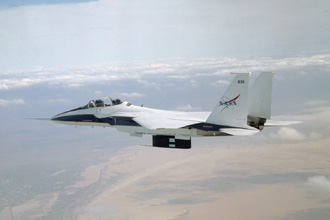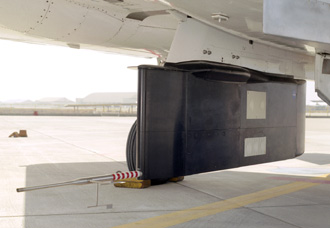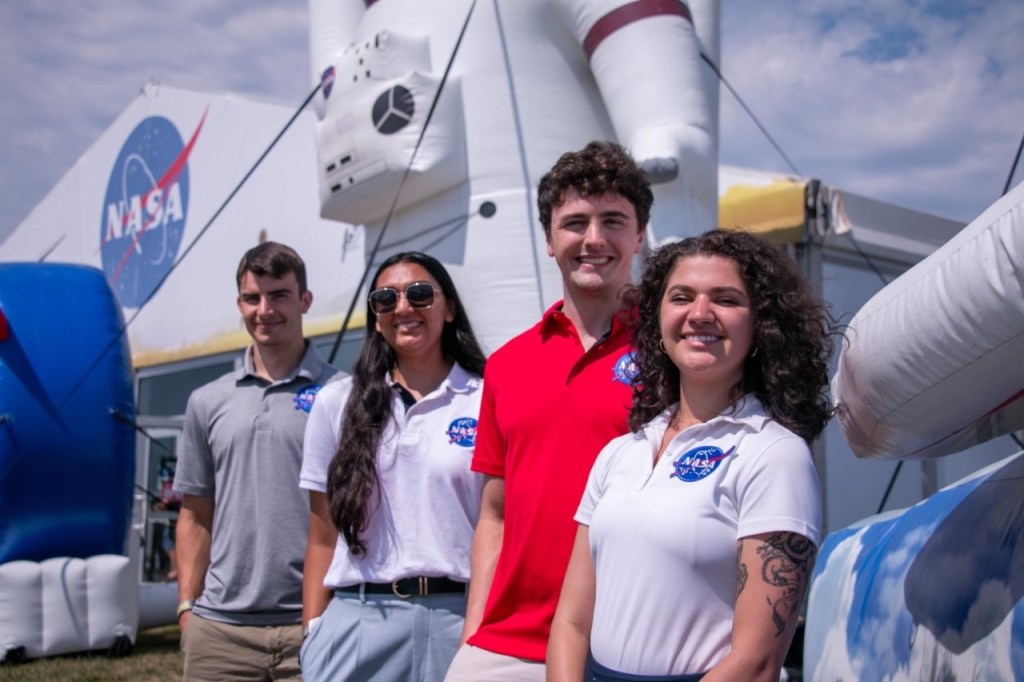To help the Space Shuttle safely return to flight, NASA engineers are acquiring data on how insulating foam debris or “divots” behave when these small pieces are shed from the Shuttle’s external fuel tank during launch.
NASA’s Dryden Flight Research Center at Edwards Air Force Base, Calif., is conducting a series of flight tests of the divots as part of the Return to Flight team effort. The Lifting Insulating Foam Trajectory (LIFT) flight test series at Dryden is using the center’s F-15B Research Testbed aircraft to test these “divots” in a real flight environment at speeds up to about Mach 2, or twice the speed of sound.
 Image Right: All six divots of thermal insulation foam have been ejected from the flight test fixture on NASA’s F-15B testbed as it returns from a LIFT experiment flight. NASA Photo EC05-0028-18 by Carla Thomas.
Image Right: All six divots of thermal insulation foam have been ejected from the flight test fixture on NASA’s F-15B testbed as it returns from a LIFT experiment flight. NASA Photo EC05-0028-18 by Carla Thomas.
Small-scale divoting occurs when the adhesive on the external tank thermal protection system (TPS) foam fails. This occurs as a result of decreasing atmospheric pressure combined with increased heating during Shuttle ascent causing air trapped beneath the TPS to expand.
LIFT project manager Stephen Corda said objectives of the current flight tests on the F-15B include determining divot structural survivability and stability in flight and quantifying divot trajectories using videography. The flight data of divot trajectories may also be used for Computational Fluid Dynamic code validation.
“We’re using the unique capabilities of the supersonic F-15B aircraft and the aerodynamic flight test fixture to provide a means to eject these debris or divots from the fixture, and then photograph them with a high-speed digital video system, where we’re able to video these divots in flight at up to 10,000 frames per second,” Corda noted.
NASA’ s Space Shuttle Systems Engineering and Integration office at the Johnson Space Center (JSC) in Houston, Texas, is funding the LIFT flight tests at NASA Dryden as part of the Space Shuttle Return-to-Flight effort. JSC aeroscience engineer Ricardo Machin said the current LIFT flight tests will help them validate the models that they use for debris transport analysis.
“In particular, it’s going to help us understand whether the divots break up once they come off the external tank, and secondly whether they will trim and begin to fly, or if they’ll tumble. The difference between trimming and flying makes a huge difference in the amount of kinetic energy that this piece of debris can impart to the shuttle,” Machin said.
 Image Left: A post-flight inspection of the panels on the F-15B’s flight test fixture shows all six divots of TPS foam were successfully ejected during the LIFT experiment. NASA Photo EC05-0030-04 by Tony Landis.
Image Left: A post-flight inspection of the panels on the F-15B’s flight test fixture shows all six divots of TPS foam were successfully ejected during the LIFT experiment. NASA Photo EC05-0030-04 by Tony Landis.
The LIFT flight test requires two new capabilities: an in-flight foam divot ejection system, and a high-speed video system to track and record the trajectories of the divots in flight. Both capabilities were developed by Dryden engineers in just over two months.
Dryden’s LIFT team designed, fabricated, and ground-tested four different divot ejection systems, completing 70 ground tests to determine and refine the best approach. NASA Dryden engineers also designed and procured the very high-speed digital video equipment, including development of a system to synchronize the cameras with the divot ejection system. In addition, they developed videography analysis techniques in order to quantify divot trajectories.
-NASA-
TELEVISION EDITORS: Interview segments and B-roll footage to support this release will be aired during the Video File feeds on NASA TV beginning on Feb. 22. NASA TV is available on the Web and via satellite in the continental U.S. on AMC-6, at 72 degrees west longitude, transponder 9, 3880 MHz, vertical polarization, audio at 6.8 MHz. In Alaska and Hawaii, NASA TV is available on AMC-7, at 137 degrees west longitude, transponder 18, at 4060 MHz, vertical polarization, audio at 6.8 MHz. For NASA TV information and schedules on the Internet, visit: https://www.nasa.gov/ntv.
PHOTO EDITORS: Still photos to support this release are available in high resolution at: http://www1.dfrc.nasa.gov/Gallery/Photo/F-15B/index.html.
– end –
text-only version of this release
To receive status reports and news releases issued from the Dryden Newsroom electronically, send a blank e-mail message to dfrc-subscribe@newsletters.nasa.gov. To unsubscribe, send a blank e-mail message to dfrc-unsubscribe@newsletters.nasa.gov. The system will confirm your request via e-mail.
Dryden Flight Research Center
P.O. Box 273
Edwards, California 93523
Phone 661/276-3449
FAX 661/276-3566
Gray Creech
NASA Dryden Flight Research Center
Phone: 661/276-2662
gray.creech@dfrc.nasa.gov
























